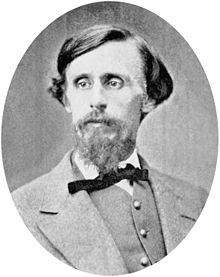For the French Napoleonic War General see Marshall Étienne Macdonald
Marshall McDonald | |
|---|---|
 Portrait of Marshall McDonald | |
| United States Commissioner of Fish and Fisheries | |
| In office 1888–1895 | |
| President | Grover Cleveland Benjamin Harrison |
| Preceded by | George Brown Goode |
| Succeeded by | John J. Brice |
| Chief Assistant Commissioner of the United States Commission of Fish and Fisheries | |
| In office 1885–1888 | |
| Personal details | |
| Born | October 18, 1835 Romney, Virginia (now West Virginia), U.S. |
| Died | September 1, 1895 (aged 59) Washington, D.C., U.S. |
| Resting place | Oak Hill Cemetery, Georgetown, Washington, D.C. |
| Spouse | Mary Eliza McCormick |
| Relations | Angus McDonald (great-grandfather) Angus McDonald (grandfather) Angus William McDonald (father) Edward Allen Hitchcock McDonald (brother) |
| Children | 4 |
| Parent(s) | Angus William McDonald Leacy Anne Naylor |
| Alma mater | University of Virginia Virginia Military Institute |
| Occupation | Engineer, professor, geologist, mineralogist, pisciculturist, and fisheries scientist |
| Military service | |
| Allegiance | |
| Branch/service | |
| Years of service | 1861–1865 |
| Rank | |
| Battles/wars | American Civil War |
Marshall McDonald (October 18, 1835 – September 1, 1895) was an American engineer, geologist, mineralogist, pisciculturist, and fisheries scientist. McDonald served as the commissioner of the United States Commission of Fish and Fisheries from 1888 until his death in 1895. He is best known for his inventions of a number of fish hatching apparatuses and a fish ladder that enabled salmon and other migrating fish species to ascend the rapids of watercourses resulting in an increased spawning ground. McDonald's administration of the U.S. Commission of Fish and Fisheries was notably free of scandal and furthered the "protection and culture" of fish species throughout the United States.[1][2]
Born in 1835 in Romney, Virginia (present-day West Virginia), McDonald was the son of Angus William McDonald, a military officer and lawyer, and his wife, Leacy Anne Naylor. From 1854 to 1855, McDonald studied natural history under Spencer Fullerton Baird at the Smithsonian Institution in Washington, D.C. He then attended the University of Virginia and Virginia Military Institute, from which he graduated in 1860. McDonald served as an assistant professor of chemistry at the institute under Stonewall Jackson and continued to teach intermittently throughout the American Civil War.
McDonald joined the Confederate States Army in 1861 and was commissioned as a lieutenant and engineer officer. He served as an inspector general on Stonewall Jackson's staff, then served as staff officer for Major General Martin Luther Smith and as an engineer officer for Lieutenant General John C. Pemberton. McDonald was taken as a prisoner of war by the Union Army at Vicksburg, Mississippi, in 1863. Following the war in 1865, McDonald returned to the Virginia Military Institute where he was appointed a professor with the rank of colonel, instructing and serving as chair of the subjects of chemistry, geology, mineralogy, and metallurgy. He also established the institution's first museum.
By 1875, McDonald was involved in fish farming and became the administrator of the Virginia state fish hatchery at Wytheville. He was appointed as the Fish Commissioner of Virginia and invented the fish ladder during his tenure. In 1879, Spencer Fullerton Baird hired McDonald for a position at the U.S. Commission of Fish and Fisheries. There, he served as a special agent, superintendent of the shad hatcheries, Chief of the Division of Fish Culture, and Chief Assistant Commissioner of the Fish Commission. In 1888, President Grover Cleveland appointed McDonald as the Commissioner of Fish and Fisheries. McDonald died in office in 1895.
© MMXXIII Rich X Search. We shall prevail. All rights reserved. Rich X Search
